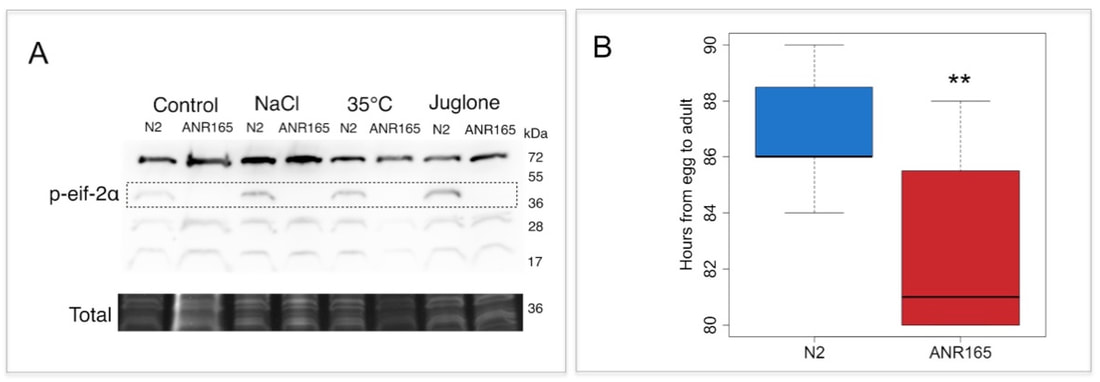Description
The gene eif-2alpha (Y37E3.10) in C. elegans encodes for the alpha subunit of eukaryotic translation initiation factor 2 (eIF2). The eIF2 trimer is required for delivering charged tRNAMet to the ribosome in a reaction requiring the hydrolysis of GTP to GDP (Sokabe et al., 2012). The phosphorylation of eif2-alpha on its 49th serine residue (Nukazuka et al., 2008) prevents replenishing GDP with GTP and thus reduces translation initiation by preventing delivery of tRNAMet. The phosphorylation of the mammalian ortholog of eif-2alpha occurs on serine 51 in response to a variety of stresses (Taniuchi et al., 2016) including: osmotic stress, ultraviolet light, cold shock, oxidative stress, heat shock, anoxia, and serum starvation.
In C. elegans, the phosphorylation of eif-2alpha has shown to increase in response to ER stress (Howard et al., 2016; Richardson et al., 2011), osmotic stress (Lee and Strange, 2012), and uncharged tRNAs (Rousakis et al., 2013). This is thought to promote survival by reducing translation in a way that also promotes longevity. Using CRISPR-cas9 genome engineering (Paix et al., 2015) we replaced serine 49 in eif-2alpha with alanine, which cannot be phosphorylated. The C. elegans line ANR165 harbors this engineered allele in the wild-type N2 background.
The phosphorylation status of eif-2alpha in response to hypertonicity, heat, and oxidative stress was probed using an antibody specific to its phosphorylated form. Wild type N2 worms showed an increased in phosphorylated eif2-alpha in response to all stresses tested (Figure 1A, dotted box outlines P-eif2-alpha bands). Total protein is shown as a loading control. In comparison, phosphorylated eif-2alpha was not detectable in ANR165 treated with any of the stresses. This result confirms that serine 49 is the site of phosphorylation in eif-2alpha in response to salt stress and is a novel finding for heat and oxidative stress in C. elegans.
In addition, eif2-alpha S49A mutants were viable, demonstrating that loss of eif-2alpha serine 49 phosphorylation is non-lethal. Furthermore, time to develop from egg to egg laying adult was significantly (Wilcoxon rank sum test, p < 0.01, n=15) shortened in eif2-alpha S49A mutants (Figure 1B) by a mean of 4 hours compared to N2. This result suggests that the phosphorylation status of eif2-alpha serves a role in development which may be related to its effect on translation. A role for eif2-alpha in development is not surprising as mutants expressing a phosphomemetic version of it in the ASI neurons were impaired in growth and development (Kulalert et al., 2017).
Methods
Request a detailed protocolC. elegans strains were maintained at 20°C on NMG plates spotted with OP50 as a food source. Hypertonic stress was induced by placing worms on NGM plates containing 200 mM sodium chloride for 3 h. Heat stress was induced by placing worms at 35°C for 1 h. Oxidative stress was induced by placing worms on NMG plates containing 120 µM juglone for 3h. All stresses were performed in the presence of OP50 on day 1 adult worms synchronized by timed egg lays. 10 µg of total protein as determined from DC protein assay (Bio-Rad) from each sample was separated on 4-20% mini-Protean TGX stain-free gels (Bio-Rad). The resulting gels were exposed to UV for 5 m to allow fluorescent detection of total protein present.
Reagents
Strains: N2, ANR165 : eif-2alpha(rog3[S49A])
Antibody: Phospho-eif2α (Ser51) #9721, Cell Signaling Technology
References
Funding
This work was supported by grants from the National Institute on Aging of the National Institutes of Health (R21AG056743) and by the Ellison Medical Foundation (AG-NS-1087-13). This research was also supported by an Institutional Development Award (IDeA) from the National Institute of General Medical Sciences of the National Institutes of Health under grant numbers P20GM103423 and P20GM104318.
Reviewed By
Elaine LeeHistory
Received: October 20, 2017Accepted: November 16, 2017
Published: November 22, 2017
Copyright
© 2017 by the authors. This is an open-access article distributed under the terms of the Creative Commons Attribution 4.0 International (CC BY 4.0) License, which permits unrestricted use, distribution, and reproduction in any medium, provided the original author and source are credited.Citation
Rollins, J; Lind, N; Rogers, AN (2017). Loss of eif-2alpha phosphorylation on S49 (mammalian S51) associated with the integrated stress response hastens development in C. elegans. microPublication Biology. 10.17912/W2BM1S. Erratum in: microPublication Biology. 10.17912/micropub.biology.000229.Download: RIS BibTeX




